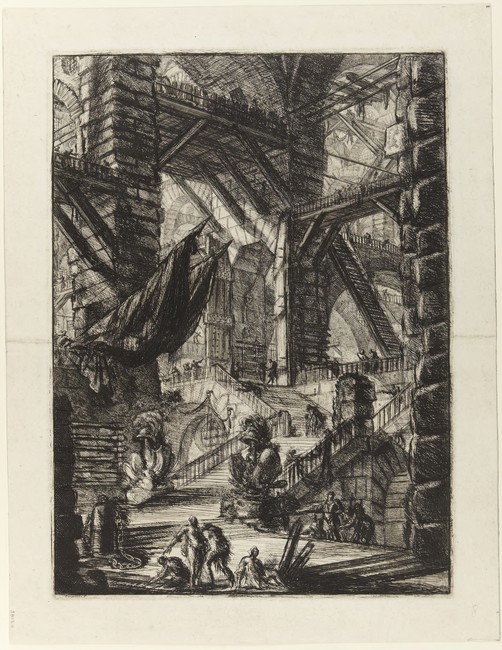Summary | Excerpt | Reviews | Beyond the Book | Read-Alikes | Genres & Themes | Author Bio

This article relates to Piranesi
 In Susannah Clarke's novel Piranesi, the titular character lives in a fantastical, labyrinthine home filled with endless hallways, rooms, statues and even an ocean. It's a remarkably inventive setting, and, as our savvy First Impressions reader Lorraine D. noticed, the protagonist's name is a reference to a likely source of inspiration for the author.
In Susannah Clarke's novel Piranesi, the titular character lives in a fantastical, labyrinthine home filled with endless hallways, rooms, statues and even an ocean. It's a remarkably inventive setting, and, as our savvy First Impressions reader Lorraine D. noticed, the protagonist's name is a reference to a likely source of inspiration for the author.
The Italian artist and architect Giovanni Battista Piranesi is best known for his etchings, including a series of 16 pieces called "Imaginary Prisons," which feature detailed designs of dungeons with intricate stairwells, torture devices, towers, pillars and arches that likely also inspired the work of M.C. Escher. Piranesi is considered one of the most significant artists of the Italian neoclassical movement.
Born in a suburb of Venice in 1720, the artist's stoneworker father is believed to have imparted some knowledge of the trade to his son, likely inspiring him to pursue architecture. Piranesi began his career as a draftsman in Rome at age 20 working for the Roman ambassador to Pope Benedict XIV. He attracted acclaim for his detailed etchings copying Roman architecture, which he sold to tourists. By 1749 when "Imaginary Prisons" was released, he had established himself as an artist of extremely original talent. He built on his success with another series of etchings called "The Views," a total of 135 plates depicting Roman buildings and attractions like the Colosseum, the Pantheon and Trajan's Forum. These pieces are exquisitely detailed, with many featuring human figures going about their lives amid these grand historical structures.
While working on this series, which incorporated the Roman ruins, Piranesi became interested in archaeology, and he published a four-volume set of prints in 1756 called "Roman Antiquities." He was made a Fellow of the Society of Antiquaries of London and also served as the director of the Portici Museum during the 1750s. During his tenure there, he was responsible for drawing newly discovered artifacts from the ruins (unfortunately, a substantial portion of these drawings have since been lost or destroyed). His work was prized for its precision. Throughout the 1760s-70s, Piranesi continued to draw and restore artifacts and antiquities, predominantly for British backers. His final work was a series of etchings of the Greek ruins of the Doric temples of Paestum, completed and published in 1778 by his son Francesco shortly after Piranesi's death.
Susannah Clarke is not the first author to be inspired by Piranesi's work, as it is said to have also influenced Romantic writers like Victor Hugo, Samuel Taylor Coleridge and Edgar Allan Poe. Piranesi once said of his own work: "I need to produce great ideas, and I believe that if I were commissioned to design a new universe, I would be mad enough to undertake it."
by Lisa Butts
"The Staircase with Trophies," part of Piranesi's "Imaginary Prisons" series, courtesy of Princeton University Art Museum
Filed under Music and the Arts
![]() This "beyond the book article" relates to Piranesi. It originally ran in October 2020 and has been updated for the
September 2021 paperback edition.
Go to magazine.
This "beyond the book article" relates to Piranesi. It originally ran in October 2020 and has been updated for the
September 2021 paperback edition.
Go to magazine.
Good as it is to inherit a library, it is better to collect one.
Click Here to find out who said this, as well as discovering other famous literary quotes!
Your guide toexceptional books
BookBrowse seeks out and recommends the best in contemporary fiction and nonfiction—books that not only engage and entertain but also deepen our understanding of ourselves and the world around us.